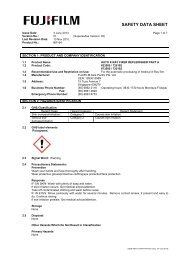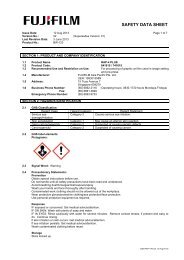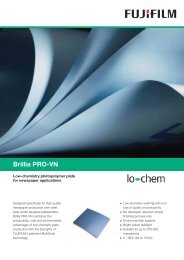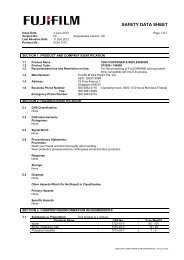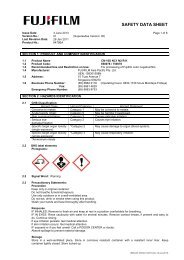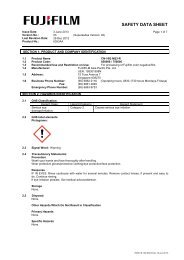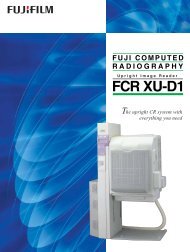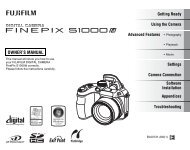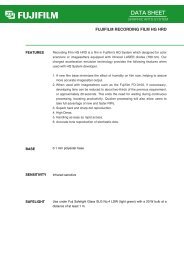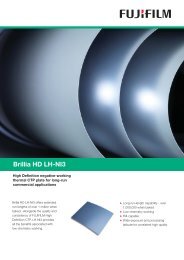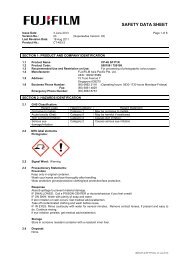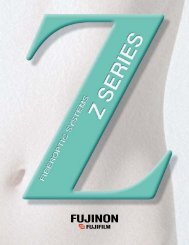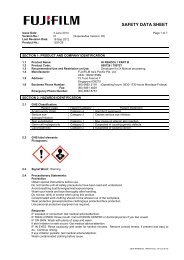The FUJIFILM Environmental Report/2001 Edition
The FUJIFILM Environmental Report/2001 Edition
The FUJIFILM Environmental Report/2001 Edition
You also want an ePaper? Increase the reach of your titles
YUMPU automatically turns print PDFs into web optimized ePapers that Google loves.
OPENING REMARKS<br />
Minoru Ohnishi<br />
Chairman and Chief Executive Officer<br />
Masayuki Muneyuki<br />
Vice Chairman<br />
As we enter the 21st century, the population of the world<br />
continues to grow at an explosive rate. <strong>The</strong> current population of<br />
more than 6 billion is expected to rise to 8 billion by 2020 and<br />
exceed 10 billion by 2050. Population growth and lifestyle<br />
changes spotlight the importance of the preservation and<br />
protection of our natural resources, safely disposing of industrial<br />
and household waste, and combating pollution caused by<br />
chemical substances. As a global company, Fujifilm regards<br />
resource preservation and protection to be the highest priority.<br />
We believe it is essential to develop new energy- and resourcesaving<br />
technologies and to adopt progressive resource policies<br />
at a global level. For Fujifilm, the biggest concerns of the 21st<br />
century are, without a doubt, environmental awareness and<br />
protection.<br />
In the past, Fujifilm has centered its environmental policies on<br />
three basic pillars: constantly giving due consideration to the<br />
natural environment, ensuring safety with regard to chemicals,<br />
and preventing the wasteful use of resources (source reduction).<br />
To meet these obligations, Fujifilm follows a Responsible Care<br />
program. Under Responsible Care, companies independently<br />
set and pursue their own policies, targets, and standards for<br />
environmental protection across the full spectrum of their<br />
activities—from product development through manufacturing,<br />
distribution, use, and waste disposal. Responsible Care is an<br />
international protocol, and chemical companies across the world<br />
have committed themselves to meeting its goals. Fujifilm<br />
became a member of the Japan Responsible Care Council at<br />
the time of the council’s establishment in 1995 and began to<br />
publicize its Responsible Care activities. To support an<br />
integrated environmental management system, Fujifilm began<br />
obtaining ISO 14001 certification prior to Japan’s formal<br />
adoption of the <strong>Environmental</strong> Management Standard in fiscal<br />
1996. All of our main Japanese plants had obtained certification<br />
before 1996.<br />
Recently, Fujifilm has initiated additional action programs to<br />
identify risks and hazards associated with chemicals, as part of<br />
Shigetaka Komori<br />
President<br />
efforts to avoid or modify the use of chemicals identified in specific<br />
classes. Risk management programs are regularly updated.<br />
Our basic identification-awareness tool is our proprietary<br />
Chemical and <strong>Environmental</strong> Safety Information Database.<br />
Through our in-house network, such information is available to all<br />
Company employees.<br />
All our policies for reducing the environmental impact of our<br />
activities are based on the following source-reduction measures:<br />
◆ Designing products with low energy consumption,<br />
◆ Reducing energy loss during product manufacturing,<br />
◆ Reducing environmental impact arising from the use of<br />
products, and<br />
◆ Recovering parts for reuse and repair while creating wastefree<br />
production cycles.<br />
A very high level of technological expertise is needed to make<br />
products environment-friendly while maintaining and improving<br />
their quality and functionality. But Fujifilm is determined to meet<br />
this challenge. A landmark achievement in this field is our<br />
environment-friendly production process for the Fujicolor<br />
QuickSnap single-use camera, which, in November 2000, won<br />
the “Nikkei Superior Trendsetting Factories and Offices Awards<br />
Millennium Award,” sponsored by the Nihon Keizai Shimbun<br />
Company, and the “47th Okouchi Memorial Technology Prize,”<br />
sponsored by the Okouchi Memorial Committee. We aim to<br />
design all our products to make them as environment-friendly as<br />
the Fujicolor QuickSnap, as we pursue source reduction.<br />
Zero Emission initiatives also form part of our source-reduction<br />
activities. Fujifilm already recycles all waste materials generated<br />
in base-material processing at its four main Japanese plants,<br />
and plans to achieve Zero Emissions for all waste products<br />
generated by all domestic business bases, including the sales<br />
division, by the end of fiscal 2002.<br />
Under the resolute leadership of Fujifilm’s management, every<br />
employee and organization within the Group is engaged in an<br />
ongoing effort to make Fujifilm a company that works for the<br />
environment and for product safety.<br />
1



